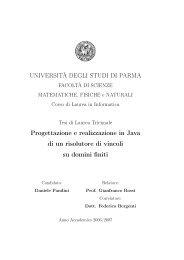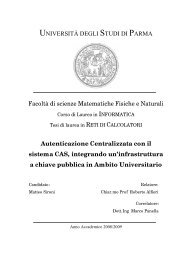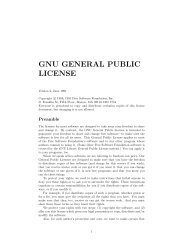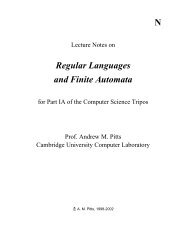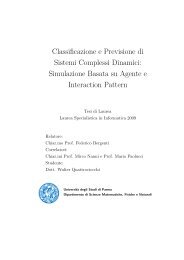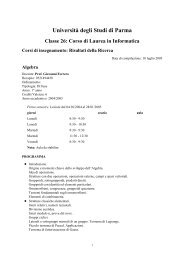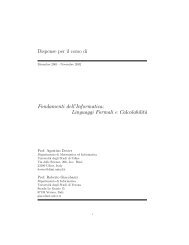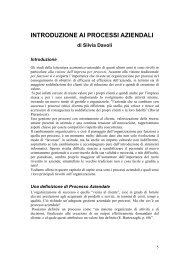a modern C++ library for the manipulation of Boolean functions
a modern C++ library for the manipulation of Boolean functions
a modern C++ library for the manipulation of Boolean functions
Create successful ePaper yourself
Turn your PDF publications into a flip-book with our unique Google optimized e-Paper software.
operator has a dominant value (<strong>for</strong> example 0 <strong>for</strong> ∧ and 1 <strong>for</strong> ∨), we can define ano<strong>the</strong>r<br />
base case when one <strong>of</strong> <strong>the</strong> two nodes is <strong>the</strong> terminal node corresponding to <strong>the</strong> dominant<br />
value and <strong>the</strong> o<strong>the</strong>r is a generic node (terminal or non-terminal): <strong>the</strong> result is <strong>the</strong> terminal<br />
node corresponding to <strong>the</strong> dominant value.<br />
For <strong>the</strong> non-base case we are considering two nodes n 1 and n 2 , where n 1 is a node <strong>of</strong> <strong>the</strong><br />
first argument and n 2 is a node <strong>of</strong> <strong>the</strong> second argument. We choose v = min(n 1 var, n 2 var)<br />
(or, if one <strong>of</strong> <strong>the</strong> two nodes is terminal, <strong>the</strong> variable by which <strong>the</strong> o<strong>the</strong>r is labeled) as<br />
<strong>the</strong> splitting variable: we can now apply Shannon expansion with respect to variable v<br />
to <strong>the</strong> <strong>Boolean</strong> <strong>functions</strong> f = n 1 D and g = n 2 D. Equation 2.1 allows us to compute<br />
f[0/v], f[1/v], g[0/v] and g[1/v]: <strong>the</strong> first two will be represented by two nodes <strong>of</strong> <strong>the</strong> first<br />
argument, while <strong>the</strong> last two will be represented by two nodes <strong>of</strong> <strong>the</strong> second argument; if<br />
one <strong>of</strong> <strong>the</strong> two nodes n 1 or n 2 was not labeled with <strong>the</strong> splitting variable, <strong>the</strong>n two <strong>of</strong> <strong>the</strong><br />
four computed nodes will <strong>of</strong> course be, in fact, <strong>the</strong> same node and will coincide with n 1<br />
or n 2 .<br />
The result <strong>of</strong> <strong>the</strong> non-base case will be, according to Shannon expansion, a non-terminal<br />
node labeled with v; its true successor is obtained by calling <strong>the</strong> algorithm recursively on<br />
<strong>the</strong> computed nodes representing f[1/v] and g[1/v], while its false successor is obtained by<br />
calling <strong>the</strong> algorithm recursively on <strong>the</strong> computed nodes representing f[0/v] and g[0/v].<br />
This algorithm, without fur<strong>the</strong>r optimization, produces a correct unreduced graph, but<br />
we can do much better while building a reduced graph by adding a few tweaks.<br />
Efficiency tweaks and hash tables<br />
In order to obtain a reduced graph, we apply reduction rules to <strong>the</strong> result at <strong>the</strong> end <strong>of</strong><br />
each recursive call: if <strong>the</strong> result <strong>of</strong> <strong>the</strong> recursive call has its true successor equal to its<br />
false successor, we discard <strong>the</strong> node and connect its predecessor directly to its successor.<br />
In order to avoid duplicate nodes, we keep an hash table with keys in Vars × N × N :<br />
each key refers to a node and contains <strong>the</strong> variable by which it is labeled, a pointer to its<br />
true successor and a pointer to its false successor (<strong>of</strong> course <strong>the</strong> two pointers must be<br />
different in order to comply with reduction rules), while <strong>the</strong> value <strong>of</strong> an entry contains<br />
a pointer to <strong>the</strong> represented node if it is already present in memory or contains NULL<br />
o<strong>the</strong>rwise. After each recursive call we look <strong>for</strong> <strong>the</strong> resulting node into memory by<br />
per<strong>for</strong>ming an hash lookup: if <strong>the</strong> node is found <strong>the</strong>n it is returned as <strong>the</strong> result, o<strong>the</strong>rwise<br />
<strong>the</strong> new node is created and an hash entry corresponding to it is added. CORAL in fact<br />
utilizes a different kind <strong>of</strong> hash table, as <strong>the</strong> table would actually grow too large <strong>for</strong> our<br />
applications if we kept an entry <strong>for</strong> each allocated node. We will not describe <strong>the</strong> hash<br />
function here; just be aware that <strong>the</strong> value <strong>of</strong> an entry is not a single pointer but a list <strong>of</strong><br />
pointers, so a lookup may require non-constant time in <strong>the</strong> worst case.<br />
For each binary operator, we also keep ano<strong>the</strong>r hash table that works as a cache <strong>for</strong> <strong>the</strong><br />
purpose <strong>of</strong> avoiding multiple recursive calls on <strong>the</strong> same pairs <strong>of</strong> nodes: <strong>the</strong> table has keys<br />
in N × N and values in N , where each value contains <strong>the</strong> result <strong>of</strong> <strong>the</strong> <strong>the</strong> application <strong>of</strong><br />
<strong>the</strong> binary operator on <strong>the</strong> pair <strong>of</strong> nodes represented by <strong>the</strong> key. At <strong>the</strong> beginning <strong>of</strong> each<br />
recursive call we check if <strong>the</strong> resulting node has already been computed by per<strong>for</strong>ming<br />
an hash lookup: if <strong>the</strong> result is found <strong>the</strong>n it is returned immediately, o<strong>the</strong>rwise it is<br />
2.3 Operations on ROBDDs 9



